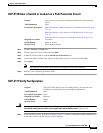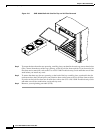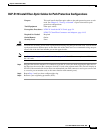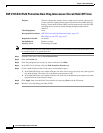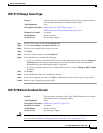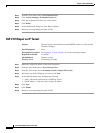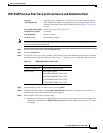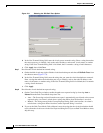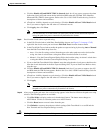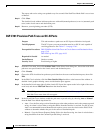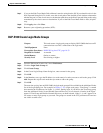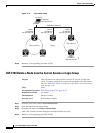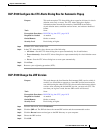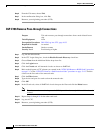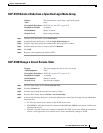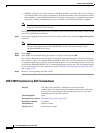
17-63
Cisco ONS 15600 Procedure Guide, R8.0
Chapter 17 DLPs E100 to E199
DLP- E180 Provision Path Trace on Circuit Source and Destination Ports
c. Click the Disable AIS and RDI if TIM-P is detected check box if you want to suppress the alarm
indication signal (AIS) and remote defect indication (RDI) when the STS Path Trace Identifier
Mismatch Path (TIM-P) alarm appears. Refer to the Cisco ONS 15600 Troubleshooting Guide for
descriptions of alarms and conditions.
d. (Check box visibility depends on card selection.) Click the Disable AIS on C2 Mis-Match check
box if you want to suppress the AIS when a C2 mismatch occurs.
e. Click Apply, then click Close.
Note It is not necessary to set the format (16 or 64 bytes) for the circuit destination expected
string; the path trace process automatically determines the format.
Step 9 Provision the circuit source expected string:
a. In the Edit Circuit window (with Show Detailed Map chosen; see Figure 17-9 on page 17-62)
right-click the circuit source port and choose Edit Path Trace from the shortcut menu.
b. In the Circuit Path Trace window, enable the path trace expected string by choosing Auto or Manual
from the Path Trace Mode drop-down list:
• Auto—Uses the first string received from the port at the other path trace end as the baseline
string. An alarm is raised when a string that differs from the baseline is received.
• Manual—Uses the Current Expected String field as the baseline string. An alarm is raised when
a string that differs from the Current Expected String is received.
c. If you set the Path Trace Mode field to Manual, enter the string that the circuit source should receive
from the circuit destination in the New Expected String field. If you set Path Trace Mode to Auto,
skip this step.
d. Click the Disable AIS and RDI if TIM-P is detected check box if you want to suppress the AIS
and RDI when the TIM-P alarm appears. Refer to the Cisco ONS 15600 Troubleshooting Guide for
descriptions of alarms and conditions.
e. (Check box visibility depends on card selection.) Click the Disable AIS on C2 Mis-Match check
box if you want to suppress the AIS when a C2 mismatch occurs.
f. Click Apply.
Note It is not necessary to set the format (16 or 64 bytes) for the circuit source expected string;
the path trace process automatically determines the format.
Step 10 After you set up the path trace, the received string appears in the Received field on the path trace setup
window. The following options are available:
• Click Hex Mode to display path trace in hexadecimal format. The button name changes to
ASCII Mode. Click it to return the path trace to ASCII format.
• Click the Reset button to reread values from the port.
• Click Default to return to the path trace default settings (Path Trace Mode is set to Off and the
New Transmit and New Expected Strings are null).
Caution Clicking Default will generate alarms if the port on the other end is provisioned with a different string.



